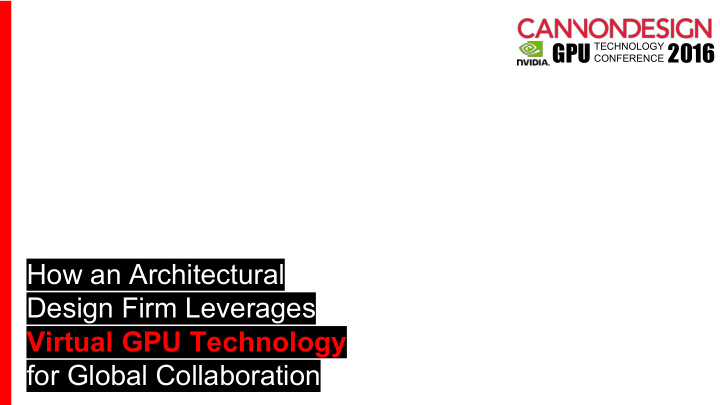



GPU 2016 TECHNOLOGY CONFERENCE How an Architectural Design Firm Leverages Virtual GPU Technology for Global Collaboration
What are we going to learn today? ● Why CannonDesign decided to virtualize our infrastructure ● What struggles we encountered specific to the tools we use ● What are the various configurations of virtual desktops we used over the years, and what were their shortcomings ● How we measured performance of virtual desktops in order to develop our future infrastructure ● What the plan is for our new infrastructure which uses GRID 2.0 technology ● What are the benefits we expect from our new design
I’m Jimmy Rotella I live at the Crossroads of Architecture & Technology @jrotella jrotella@cannondesign.com
Andrew Schilling IT Coordinator Information Systems aschiling@cannondesign.com
16 offices 1000 employees # 12 an integrated global design firm that unites a dynamic team of strategists, futurists, researchers, architects, engineers, and Top Design Firm industry specialists Architect 50
our JOURNEY through virtualization begins here .
why virtualize? Cost Security
why virtualize? Cost Security ● startup costs are high ● data tends to be more secure, as it all resides on virtual desktops however it’ ● cost savings at the desktop level are s only as secure as you make your typically redirected to servers, environment network, and storage ● gives you more control over setting ● some virtual desktop infrastructure permissions and restrictions, however setups allow for reduced license some cultures and environments claim requirements and costs, but not all that hinders their work ● ROI takes longer than server ● “all your eggs in one basket” virtualization project robbing peter only as secure as to pay paul your restrictions
why did we virtualize? Management Collaboration ● easier workstation provisioning with ● SFMO (Single Firm Multi Office) standard desktop images (this ended ● Workstation access from anywhere up not being a benefit for us later) ● greater flexibility and mobility for ● IT support does not need to happen at project teams end user’s desktop location ● ability to share and reallocate ● unified backup and recovery resources as users need them
why did we virtualize? Management Collaboration ● easier workstation provisioning with ● SFMO (Single Firm Multi Office) standard desktop images (this ended ● Workstation access from anywhere up not being a benefit for us later) ● greater flexibility and mobility for ● IT support does not need to happen at project teams end user’s desktop location ● ability to share and reallocate ● unified backup and recovery resources as users need them ALL HUGE only reap benefits if you are BENEFITS FOR US leveraging identical images
ability to invite outside consultants into our network for collaboration 16 offices worldwide all tied back into data center globally share projects and work on the same files
What REVIT wants….
What WE want revit to do for US ! What REVIT wants….
This is Revit.
How REVIT works. bring the PEOPLE to the DATA
REVIT + WAN =
Virtual Desktop Design Version 1 - Standard VDI Version 2 - GPU VDI Version 3 - CHUM VDI (2008) (2013) (2014) ● 2 vCPU @ ● 2 vCPU @ ● 2 vCPU @ ● 140GB hard drive ● 150GB hard drive space ● 180GB hard drive space space ● 12GB RAM ● 24GB RAM ● 8GB RAM ● vSGA hardware graphics ● vDGA passthrough GPU ● vSGA software GPU acceleration graphics acceleration graphics accelerations
Why didn’t vSGA work for us?
we needed more power. racked workstations ● 2u servers ● 12 core xeon cpu ● dedicated graphics card ● PCoIP pass through graphics ● 1 user per system
What we ended up with was a very mixed environment. {circa early 2015}
How can you efficiently manage an environment like this?
What is our bottleneck?
RFObenchmark
Cinebench
Holomark
PCmark
The “Taylor Swift” Test
so how did we stack up? Other physical machines. What our users consider “good”. Not where we want to be. (lower is better)
it’s important to set your own baseline to define user experience. FOR US OUR BASELINE WAS ALL ABOUT FEEL AND WE FOUND RFOBENCHMARK HW ACCELERATION TESTS AND CINEBENCH TESTS This became our COMPARED WITH ACTUAL baseline for END USERS DATA GAVE US performance OUR BASELINE
(lower is better)
worst case scenario.
what’s in store for the FUTURE of CannonDesign?
New HOTness. Cisco UCS w/NVIDIA GRID 2.0 ● Cisco B200 M4 Blade Servers ● Cisco 5100 Series Chassis w/ 8 servers per 6u rack space ● 1 Tesla M6 card per server ● 2x 2.6 GHz 14 core Xeon Processors per server ● 384GB RAM per server ● NetApp SSD storage array
Virtual Desktop Profiles Knowledge Workers Designers Renderers ● 2 vCPU @ 2.6 GHz ● 8 vCPU @ 2.6 GHz ● 12 vCPU @ 2.6GHz ● 256GB hard drive ● 512GB hard drive ● 512GB hard drive ● 8GB RAM ● 48GB RAM ● 48GB RAM ● 512mb vGPU ● 1GB vGPU ● 2GB vGPU ● 16 users per blade ● 6 users per blade ● 2-3 users per blade
VDI users see a savings of 310 sec RWS users see a savings of 10 sec How do we expect when Rotating, Orbiting, & Panning, when Rotating, Orbiting, & Panning, to benefit from our Zooming, and 86 sec when creating Zooming, and 26 sec when creating models and exporting them. models and exporting them. new infrastructure? REDUCTION IN TIME PERFORMING REVIT TASKS Previous VDI users will see savings of 13.5 hours per week using Revit, which equates to approximately $2500 per week in billable hours 85% REDUCTION IN SERVER SPACE
questions? jrotella@cannondesign.com aschilling@cannondesign.com
Recommend
More recommend